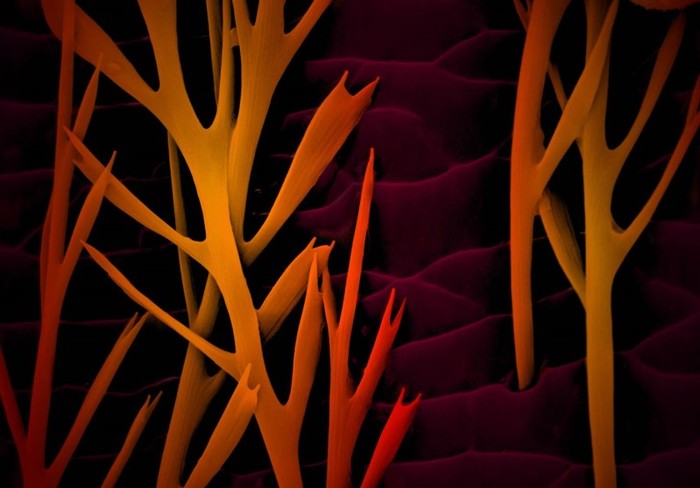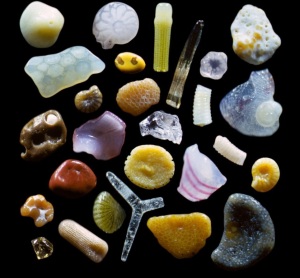I was blown away by the screening of Jean Painleve’s Oursins (sea urchins). Professor Cartwright explained that Painleve emphasized that his work was explicitly an aesthetic endeavor— he aimed to create surrealist films of underwater ecologies that contain the dramas of life that typically go unseen by man’s eye. I grew up in a beach town and have seen my fair share of sea urchins, but never before in the way that Painleve captured them.

Advancements in imaging technology have allowed other artists to realize Painleve’s goal of portraying existing aesthetics otherwise unseen by the human eye. Advanced imaging has also given artists a platform to creatively interpret the typically black and white images captured by the technology. Louise Hughes is a biological electron microscopist who has “worked in the field of medical research and electron microscopy for 13 years“. She explains that the images she captures are in black and white and she adds false color to them to make them more appealing. Her work perfectly captures the blurred lines between art and science— as a scientist she handles the lab equipment, but as an artist she frames and colorizes the specimen.

Similar to Hughes, Dr. Gary Greenberg is a scientist with a Ph.D in biomedical research who uses microscopic imaging to reveal worlds unseen. Not only does he utilize advances in imaging as an artist, he is responsible for said advances as a scientist! He “invented and developed high-definition, three-dimensional light microscopes, for which he was issued eighteen US patents“. Unlike Hughes, Dr. Greenberg does not interpret the images with his own color overlays. The attached image is one of unedited beach sand under a microscope. As I mentioned earlier, I grew up next to the beach, but I had no idea that the tan grains I regularly walked upon actually resembled tiny, colorful works of abstract sculpture. On his website that I have linked, Dr. Greenberg states that his mission is “to reveal the secret beauty of the microscopic landscape that makes up our everyday world”. Sounds like Painleve, right?
Artists can also use their work to raise awareness, as covered in this week’s reading. A theme I have been exploring is the act of revealing worlds unseen, which is essentially what raising awareness is all about. Mandy Barker’s Soup series aims to raise awareness about the enormous gyres of plastic debris that are continuously growing and further polluting our oceans. Barker explains that she feels directly photographing water pollution isn’t effective. She states, “You can see pictures of rubbish floating down a river, but you don’t really take it in… I think people kind of get anesthetized by images they see every day.” By aesthetically arranging the trash, she hopes to intrigue viewers. She explains that if the debris looks “enticing”, then people might spend a longer time viewing it and thus a longer time contemplating what it represents.
Ultimately, artists have the power to reveal realities that other people either physically cannot observe or are otherwise unaware of. Advances in imaging have shown us what is inside of our bodies, what exists at a microscopic level, what happens at the bottom of the ocean, and even glimpses of far off galaxies. But there are horizons yet to be pioneered. When will we see inside the nucleus of an atom? Will we ever be able to record our dreams? How powerful will telescopes become and what will we find on distant celestial bodies? And what will the artist’s role be when these imaging technologies arrive? Only time will tell.
-Rebecca Fisher
This is a fabulous post. I like at the end when you start speculating on possible designs…a great mode for invention, consideration, possibility! This sort of projecting and questioning is how many of the artists arrived at the works we see in class.
LikeLike